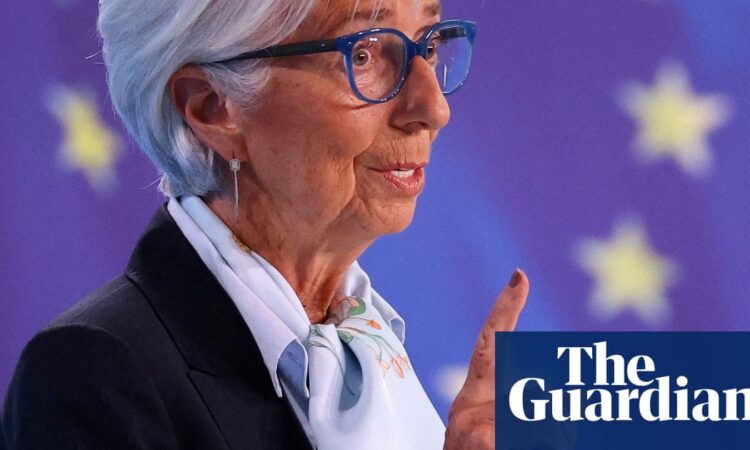
The European Central Bank has eased the pressure on borrowers across the eurozone after cutting its main interest rate for the first time in almost five years.
Citing a sustained fall in inflation, the ECB said its deposit rate would be cut to 3.75% from a record high of 4%, putting it ahead of the US Federal Reserve and the Bank of England, which have yet to cut interest rates.
Financial markets eagerly anticipated the first eurozone cut since September 2019, which will also affect the ECB’s main refinancing operations rate, which fell from 4.5% to 4.25%.
City analysts had forecast the reduction in borrowing costs at the ECB’s June meeting after signals that the central bank was ready to offer more support to eurozone economies after a period of economic stagnation following the Russian invasion of Ukraine.
In a statement, the ECB said: “Keeping interest rates high for nine months has helped push down inflation. It is now appropriate to moderate the degree of monetary policy restriction.”
The ECB president, Christine Lagarde, said the central bank was confident that its forecasts were robust and if inflation continued its longer term downward trajectory, interest rates would continue to fall.
She said: “It is on the basis of the reliability, solidity, robustness and strength of our projections that we have made the decision to cut.”
Lagarde said pay settlements were moderating and companies were absorbing some of the increase in labour costs rather than passing them on to consumers, dampening inflationary pressures.
However, she added that there were still risks to the outlook for inflation, saying: “Despite the progress over recent quarters, domestic price pressures remain strong as wage growth is elevated, and inflation is likely to stay above target well into next year.”
Dean Turner, the chief eurozone economist at UBS Global Wealth Management, said the outlook for inflation, as indicated by the ECB’s latest projections, point to further interest rate reductions later this year.
Turner said: “Of course, the timing of the next move from the ECB is uncertain, as this will be dependent upon incoming data. But with the disinflationary process firmly under way, the ECB, along with other central banks, should feel confident enough to ease policy, most likely at a pace of one cut per quarter.”
However, the ECB expects inflation to be marginally higher this year and in 2025 than it was forecasting in March. It said inflation would average 2.5% in 2024 and 2.2% in 2025, up from its previous forecast of 2.3% and 2%, respectively.
Mark Wall, the chief European economist at Deutsche Bank, said the higher than previously forecast inflation numbers would make ECB policymakers more circumspect about futures cuts.
Financial markets expect just one further reduction this year and three next year, knocking a further one percentage point off eurozone interest rates by the end of 2025.
after newsletter promotion
Wall said: “The statement arguably gave less guidance than might have been expected on what comes next. In that sense, the immediate tone is a ‘hawkish cut’. This is not a central bank in a rush to ease policy.”
Strains with the eurozone are expected to show as economies recover from the pandemic and initial impact of the Ukraine war at different speeds. Croatia, which recently joined the euro, and Romania are among countries that are expected to grow by more than 3% this year, according to the European Commission, with inflation running at 3.5% and 5.9% respectively.
Projections by the commission show the economies of France and the Netherlands will expand by less than 1% this year with an inflation rate of 2.5% in both countries.
Lagarde said the ECB was aware of the variations across the currency bloc, but it was the central bank’s job to set interest rates based on average rates of growth and inflation.
Economic growth across the eurozone is expected to improve after better-than-expected performances in Germany, Italy and Spain.
The average growth rate for the eurozone would be 0.9% in 2024, 1.4% in 2025 and 1.6% in 2026, the ECB said.





